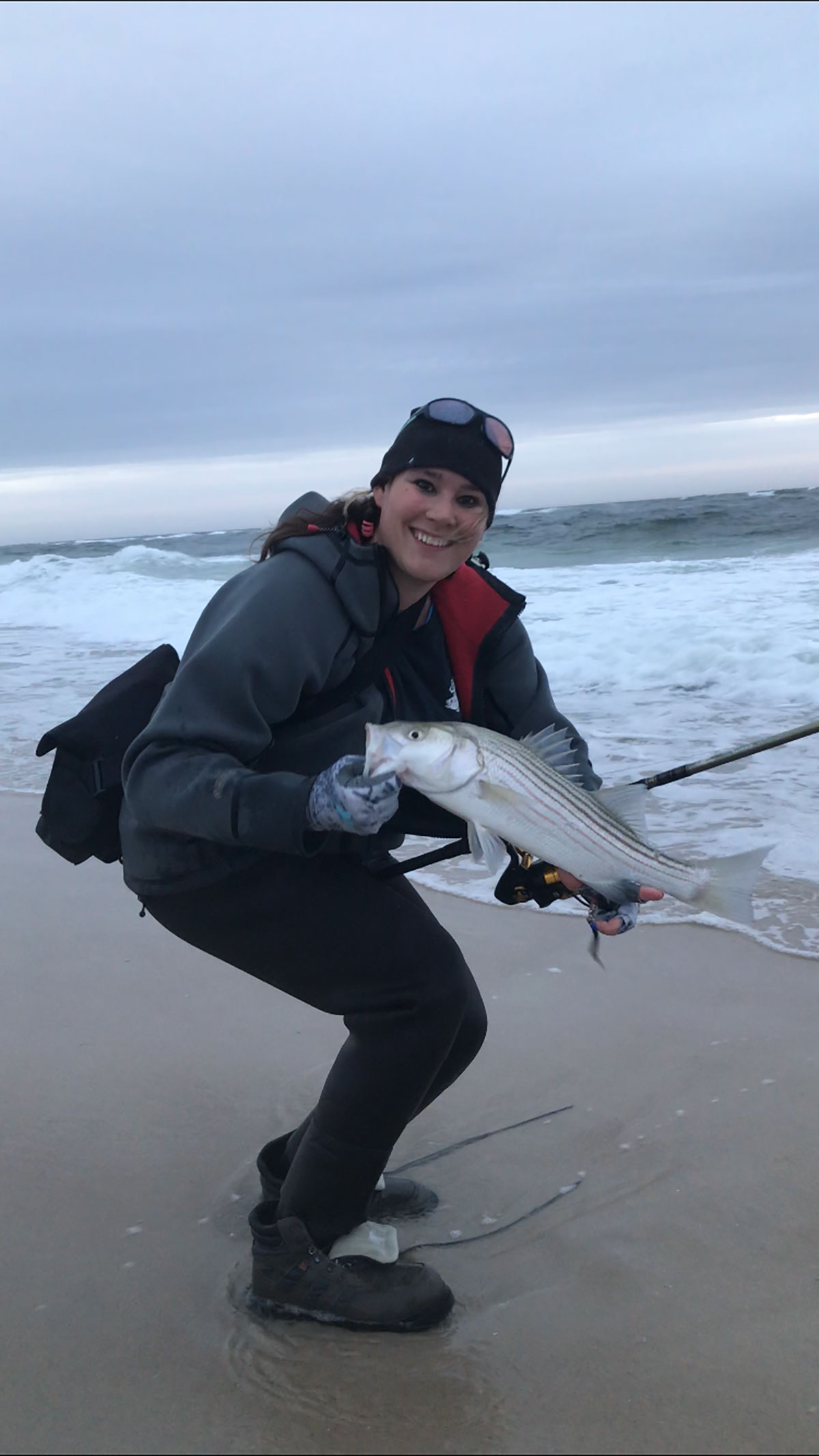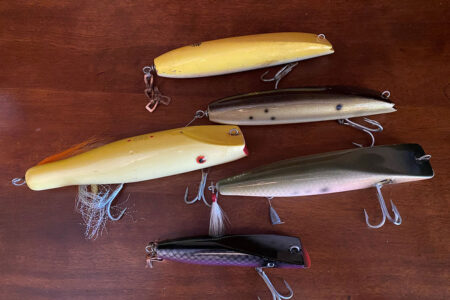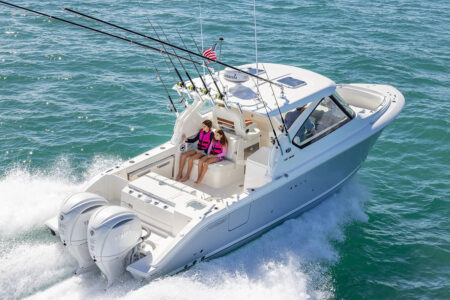
Having all of these school bass around provides a great opportunity to introduce newcomers to the surf fishing game, especially if those newcomers are youngsters.
If you are headed to the beach this fall with visions of 40-pound stripers dancing in your head you are either delusional, dreaming or living in the past when on any given night you felt there was an opportunity to score a cow. It’s been made pretty clear that the number of big striped bass in the fishery is down, but on the other hand, there are lots of small bass in the fishery as a result of several recent good year classes from Chesapeake Bay and the Hudson River. That’s the good news for casters working up and down the Striper Coast, and that’s especially the case for this fall. Those young fish have provided blitz type action that hasn’t been seen in Montauk since the 1990s and early 2000s with multiple schools of fish boiling the surface on both the north and south sides of the Point numerous times since early September. There have been many excellent days already this fall along the sand beaches of the South Fork and South Shore with many of the fish in the 22 to 27-inch range as opposed to the past couple of seasons where many of the fish measured anywhere from 12 to 22 inches. Those small fish and the virtual lack of any quality fish may have been to blame for a noticeable decline in surf fishing effort. This year, the better average size of schoolies, plus an increase in the number of keepers mixing in with shorts has drawn scores of casters to the Island’s beaches. Some quality fish have also found their way into the mix in scattered locations, adding another dimension to the fishing that has been pretty much lacking the past few seasons.

Let’s not lose sight of the fact that it is still schoolies, most of which are below the 28-inch minimum, that are generating the bulk of the action. These fish are perfect targets for scaled down tackle when surf conditions permit, or when targeting them on quiet backsides or in harbors and bays. And, given the quality and power of today’s light action rods, combined with the virtues of braid, there should be little fear of not being able to handle that very occasional bigger fish should it crash the party. On the flip side, catching these schoolies on rods better suited for trout and largemouth bass adds a whole new dimension to the game.
Defining light tackle is in the eyes of the beholder. What some consider light tackle, others might scoff at. Very often the surf conditions dictate just how light you can go with your tackle. My pet rod is a 6-foot Loomis designed for freshwater bass fitted with a 2500 series reel spooled with 10-pound test braid and finished off with a four-foot shot of 20-pound test fluorocarbon. This outfit is perfect when the surf is flat and the fish are within casting range, or when probing quiet backsides. I’ve beached hundreds of bass up to 15 pounds on this tackle the past few seasons and with a properly set drag (spell that t-i-g-h-t), the fish are landed quickly and back in the water in seconds. To those who preach we should leave these fish alone instead of playing catch and release, I say hogwash. With the cooler water temperatures of late fall, single hook lures and a thumb grip of the lip, fish can be released in seconds and the mortality rate is virtually non-existent.
Many casters favor something more along the lines of a 7 to 7-1/2 footer matched to a 3000 or 3500 series reel spooled with 15 or 20-pound braid. There’s a comfort zone there for those concerned with connecting to a bigger fish, and also the added ability to toss a little heavier payload at greater distances. Also, if you are going to limit your arsenal to a couple of rods, this outfit is a nice complement to your standard 10 or 11 footer. It can also serve double duty if you like to ply the summer surf for fluke.

As much fun as it is catching schoolies on light tackle, surf conditions may make it impractical or even futile at times. When the surf kicks up, it may require heavier payloads like A27 jigs or bucktails of 2 ounces or more to fish effectively. There will also be times, even when the fish are feeding heavily on sand eels, that long casts are required to reach the fish and that’s where your 10 or 11 footer comes into play. I make it a point to always have a light tackle outfit in the truck, along with my big rod. When conditions are right, the small rod comes into play.
Since the vast majority of fish you catch will be released, virtually all of them considering the one fish bag limit and the abundance of shorts, it behooves all of us to stick to single hook lures whenever possible. These schoolies are easy targets for bucktails, soft plastics on jig heads, diamond jigs and an assortment of tins and teasers. The single hooks make for a quick and safe release. If you want to plug these fish, consider switching trebles to single in-line hooks, and if you do go with trebles, keep it to one with a single tail hook. Any use of trebles should include crushing the barbs. It is not only better for the fish, but if you end up with a hook in your hand, you will truly appreciate the benefits of a crushed barb.
The early stages of this year’s fall run has been marked by a broad range of baitfish, including peanut bunker, sand eels, mullet, spearing, snappers and bay anchovies. That blend of baitfish has also resulted in the fish being susceptible to a wider range of artificials. Bucktails cover a broad range of forage and are a must in your arsenal. In November and December of 2017, I used the same naked, 1-ounce Premium Bay Anchovy bucktail to catch hundreds of schoolie bass on the front and backside of Democrat Point. It stayed tied to my rod for six weeks and has since been retired, minus one of its eyes. Leadheads in the ¾ ounce size range dressed with curly tail grubs, Bass Assassins or similar soft plastics always seem to take their share of schoolies, especially when sand eels are the dominant baitfish. Metals like 007 diamond jigs with tubes, Charlie Graves narrow body models, and 6 and 7-inch Tsunami Swim Eels can also be very effective when the fish are on sand eels. When peanut bunker are in the wash, it’s tough to beat 4 and 5-inch swim shads. All of these lures can easily be handled with the small rod.
Having all of these school bass around provides a great opportunity to introduce newcomers to the surf fishing game, especially if those newcomers are youngsters. When the bite is on, they are relatively easy to catch and can be caught in good numbers. If the surf conditions are right, kids can fish with lighter tackle that is easier to handle for them, adding to what can be a very positive experience, along with instilling a catch and release ethic.





